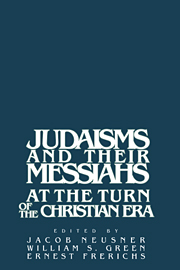Book contents
- Frontmatter
- Contents
- Preface
- List of Contributors
- 1 Introduction: Messiah in Judaism: Rethinking the Question
- 2 Wisdom Makes a Difference: Alternatives to “Messianic” Configurations
- 3 Salvation without and with a Messiah: Developing Beliefs in Writings Ascribed to Enoch
- 4 How the Authors of 1 and 2 Maccabees Treated the “Messianic” Promises
- 5 Messianism in the Maccabean Period
- 6 Waiting for the Messiah: The Spiritual Universe of the Qumran Covenanters
- 7 Philo and Messiah
- 8 Messiah and Gospel
- 9 Christology in Mark's Gospel
- 10 The Question of the Messiah in 4 Ezra
- 11 From Jewish Messianology to Christian Christology: Some Caveats and Perspectives
- 12 Mishnah and Messiah
- General Index
- Index to Biblical and Hermeneutical Texts
6 - Waiting for the Messiah: The Spiritual Universe of the Qumran Covenanters
Published online by Cambridge University Press: 08 January 2010
- Frontmatter
- Contents
- Preface
- List of Contributors
- 1 Introduction: Messiah in Judaism: Rethinking the Question
- 2 Wisdom Makes a Difference: Alternatives to “Messianic” Configurations
- 3 Salvation without and with a Messiah: Developing Beliefs in Writings Ascribed to Enoch
- 4 How the Authors of 1 and 2 Maccabees Treated the “Messianic” Promises
- 5 Messianism in the Maccabean Period
- 6 Waiting for the Messiah: The Spiritual Universe of the Qumran Covenanters
- 7 Philo and Messiah
- 8 Messiah and Gospel
- 9 Christology in Mark's Gospel
- 10 The Question of the Messiah in 4 Ezra
- 11 From Jewish Messianology to Christian Christology: Some Caveats and Perspectives
- 12 Mishnah and Messiah
- General Index
- Index to Biblical and Hermeneutical Texts
Summary
The vision of an “Anointed King” – Hebrew mšîa and Greek christos – who will rise in a diversely determined or altogether undetermined future, was deemed by Martin Buber to constitute “die zutiefst originelle Idee des Judentums,” deeply rooted in the biblical world. The concept emanates from the existential chasm that exists between the actual socio-religious and political human condition and the fervent hope for an immaculate, ideal future age that the “Anointed” will ring in.
The messianic age maintains a focal, although differently accentuated position in the Jewish and Christian faiths. Therefore, “Messianism,” its meaning and evaluation, constitutes a credal and intellectual challenge for each generation of Jews and Christians, calling for a separate, internal reassessment at every juncture of history.
The Qumran Discoveries
In our own time an additional factor justifies a reopening of the discussion: the discovery of documents from the turn of the era that contain new information on some configurations of the messianic idea in the critical period that witnessed the parting of the ways for Judaism and Christianity. I refer to the well-known manuscript finds in caves located in the area of Qumran in the Judean Desert, which at first often were and sometimes still are designated by the misnomer “The Dead Sea Scrolls.” Restrictions of space prevent me from reviewing here in detail the history of their discovery and from presenting a thorough analysis of the materials salvaged from the caves and the structure of the community that deposited them there. Nor is such a survey required in the present framework.
- Type
- Chapter
- Information
- Judaisms and their Messiahs at the Turn of the Christian Era , pp. 111 - 138Publisher: Cambridge University PressPrint publication year: 1988
- 1
- Cited by



